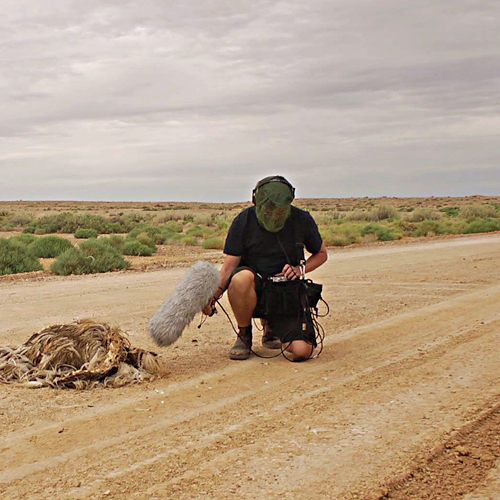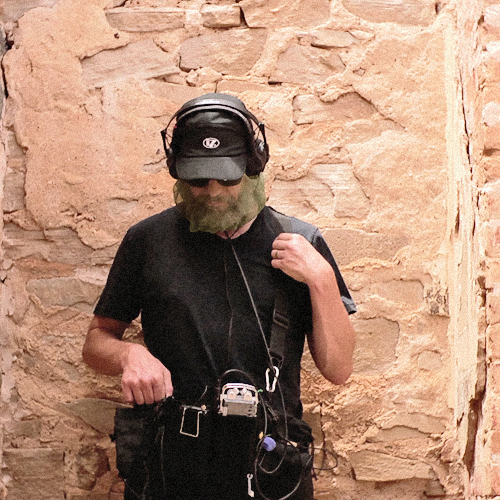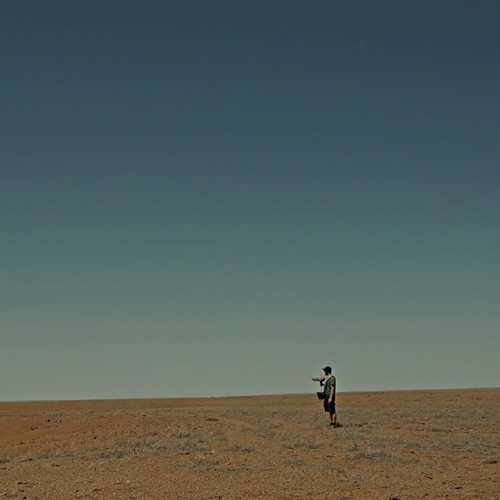Interview with Peter Lenaerts
by Chris Whitehead
A conversation with Peter Lenaerts
By his own admission Peter Lenaerts has been obsessed by silence for years. He sees it as the space in which sound happens. Silence is also a space in which questions spontaneously germinate: Where should we go to find it? How will we know it if we do? How can we collect it and show it to others? Does it even exist at all?
So a project doomed to failure, but a failure of great interest and endeavour. I wanted to ask Peter about his attempts to home in on his elusive target and how he thought his recordings mirrored the ongoing search.
INTERIORS AND EXTERIORS
In Private Rooms (Surfacenoise Recordings SN06) small, interior resonances are examined from within small cubicles which are themselves within buildings, whereas Quies (Very Quiet Records VQR004) is a document of the vast space at the heart of Australia, austere and boundless. Are both approaches a search for the same grain of truth?
P.L. The original desire was the same with both. The reality turned out differently, to record space and air.
CW: Why did you want to record space and air?
P.L. There are several reasons, but it’s summed up best by what I wrote for an application when I first started Quies:
“I want to work on silence. And absence. And nothing. The lack of. Just space. And air. That moment when the last note has rung, the last line has been delivered, the last movement has been executed. Just before the audience breaks out in applause or boos. That moment of anticipation. Of holding your breath. Your senses, exalted and wired. All ears. That moment. Exactly that moment.
What do we hear when there’s nothing to listen to?
What do we listen to when there’s nothing to hear?”
Or to put it differently, I wanted to focus on the flipside, if you will.
CW: ‘That moment when the last note has rung’, how long can that moment be extended? Some of the tracks are quite long.
PL: To compare it to music, when writing a melody you can focus on the actual notes, or you can focus on the space between the notes. The thing is that Quies is a recording project, not a composition project. So the moment cannot be extended by me, I just have to accept what I encounter. In the case of Private Rooms, some of the recordings sounded very quiet to my ears, but less so to microphones.
CW: Is that because we listen differently when playing back what we’ve recorded, as opposed to what we hear at the time through naked ears?
PL: There’s a big difference I think yes. In the first case, we are embedded in reality, soaking it up. In the second case, we are listening to a recording, through headphones, or speakers. Everything is different, the intention most of all.
CW: I think our other senses are also soaking up the environment when we’re in it, but when listening later we solely rely on our ears. Would you agree? I’m thinking of your recommendation to listen through headphones in a quiet place.
PL: From many to just one of the senses? Yes, that’s a good way of putting it. Especially in the case of a recording like Quies, you won’t hear much if you don’t listen with headphones, and even then…
CW: There is a lot once your ears become accustomed. I imagine a very low horizon and a huge sky.
PL: I agree that there is a lot, and I’m happy at least someone has taken the time to create the right circumstances and listen.
[Peter Lenaerts: photo courtesy of Ezra Eeman]
SOUNDS AND IMAGES
The process of making Quies was filmed by Ezra Eeman who travelled into the interior of Australia with Peter. These images, together with a spoken word text, are designed to be shown as part of a multimedia presentation of Quies.
Taking its coordinates from Peter’s methods and aesthetics, Ezra Eeman’s film uses detail and texture to physically mirror the fluctuations in tone and ambience that occur in Quies. The film is crystaline, dry and unobtrusive. I first saw it after I had been well acquainted with the soundworld of Quies for some time.
PL: Did the film help or hinder you? I mean, the images.
CW: It helped I guess. It is made with great understanding of your style. I noticed there were several examinations of textures and objects in the film: Driving through the outback, the salt lake, stones at night, a towel on a bed in a hotel room, an illuminated Santa etc. These made the film whole for me.
PL: That’s good to hear. I’m asking because quite often it’s the other way round. Especially in the performance I made, most people get so taken in by the sound that when the image arrives they find it intrusive. Some even keep their eyes closed and listen.
CW: Interesting. I think the film is not really a depiction of the soundtrack in this case. It’s about your methods and ideas. A companion piece to the recordings.
PL: I think so too, yes. The Quies performance is like a theatre performance. It’s part text, part sound piece, and then the film. So it’s not a concert-performance, if you know what I mean.
CW: How does the text fit in?
PL: The performance starts with a text about failure. It’s about setting a tone for me, creating an environment in which people feel comfortable and invited, setting a mood if you want. While I talk, the lights fade to black so that we’re plunged in darkness by the end of the text. Then the sound takes over.
CW: Did making Stills + Postcards from the Centre, your first journey into this empty continent (Surfacenoise Recordings SN01), lead to Quies? Did it concentrate your thoughts?
PL: Oh, it very much did yes. With Postcards, there was mostly desire and intuition, and just the craziness of flying and driving into a very remote area in the height of summer all by myself. Quies then was a proper project, with proper funding, and concepts, and thinking and research etc. It was also to some extent a collaboration with the filmmaker Ezra Eeman of course.
Recording all alone is very different from having someone near, especially when they’re filming you.
CW: Was the film maker there all the time? Luckily he seems to have kept nice and quiet.
PL: Well he was to some extent. I think Quies would have been completely different if I had gone out there all alone. His presence was impossible to ignore, but once that was established, I worked with it, or around it.
CW: It was worth it because it left us with a contextualizing document. I like that.
PL: Oh yes, absolutely, and it made me learn a lot.
CW: In Postcards there is a rather disturbing story on the radio about bullying at work. I found that a bit jarring.
PL: The thing is that I am someone who needs or wants clear concepts and ideas when I plan new work. A discourse, if you like. But then when you plunge yourself into the work, I also need to let go of what I thought. And let the reality sink in, and take over. Postcards, is first of all a documentary for me, and that’s why all the stories are there.
It’s a harsh country, Chris.
CW: Why did you choose that country
PL: It chose me. I met one of its inhabitants in Brussels and followed her out there.
CW: Was it in Australia that you came closest to recording silence and air? To achieving your aim? The closest to non-failure?
PL: Yes it was, in a motel room in Coober Pedy. It’s a dug out, like many houses in Coober Pedy. It gets so hot there, that people live ( partly ) underground. When I woke up there the first morning on my Postcards trip, there was just nothing.
CW: What did your brain do?
PL: Freak out
CW: As a species we cope poorly with low input don’t we?
PL: Our brain is hardwired for sound. It will always try to hear something. That Cage in the anechoic chamber story? I had that in an underground church in Coober Pedy. Very troubling.
CW: So why carry on the search outdoors?
PL: Because the search for quiet is not the end game. It’s about listening for nothing, indoor, outdoor, everywhere.
ARCHITECTURE AND MORALITY
CW: What will you do next?
PL: Micro(scopic) sound and architecture. I’m starting a new project where I want to listen to buildings and cities. Especially new cities. It begins from this question: How do you built a city and a building, and how do you take sound into account?
CW: Are you an artist, a researcher, a documentarist, or don’t these tags matter?
PL: They matter to some extent. But in my very personal opinion, there’s no artist without research or documentation – it all ties in together.
CW: What effect does the sound in cities have on the inhabitants at the moment, and how could it be optimised? Is that a valid question?
PL: It’s a very broad question Chris. I should specifiy that I’m specifically excluding European cities from my project.
My focus for now is on two cities: One new city in China, that is barely 15 years old, and Sydney, which as a metropolis is also fairly new. I want to record of course, but I also want to research how and whether architects and urban planners take sound into account, not just when designing buildings, but cities as well. Especially new cities.
It’s very much about the senses again, because most of us perceive reality by vision mostly, and our ears quite often just supply the soundtrack to what we see. Any sound that doesn’t fit with what we see is ignored or filtered. I’d like to throw that around, recalibrate the senses, if you want.
Listen first, and then look.
* Upper photo Peter Lenaerts, photo by Ezra Eeman





